What Is a Website Database? Types & Top 10 Picks for Singapore Businesses in 2025
In today’s digital age, website databases are the backbone of most online applications, storing and managing the data that powers dynamic user experiences. From e-commerce platforms and content management systems to interactive web applications, databases for websites are essential for businesses that want to scale, deliver personalized experiences, and stay competitive.
In this guide, we explore the types of website databases, break down the top 10 databases for web applications in 2025, and provide tips specifically tailored to Singapore companies looking to streamline their web development projects. Let’s dive in!
Table of Contents
- What is a Website Database?
- Which Websites Require a Website Database?
- How Does a Website Database Work?
- Types of Website Databases
- How Database Management Systems Help Run Business Operations
- Key Features of an Ideal Website Database for Singapore SMEs
- Top 10 Databases for Web Applications to Consider in 2025
- How to Choose the Right Database for Your Web Application (+ Singapore-Specific Tips)
- Trends in Website Databases for 2025 and Beyond
- Why Choose Kaopiz for Website Database Development
- Conclusion
- FAQs
What is a Website Database?
A website database is a structured collection of data that is used to store, retrieve, and manage information on a website or web application. Instead of manually updating and maintaining static pages with hard-coded data, websites leverage databases to dynamically serve content to users in real time. This means data—such as text, images, and user information—is stored in a database and retrieved automatically whenever needed.
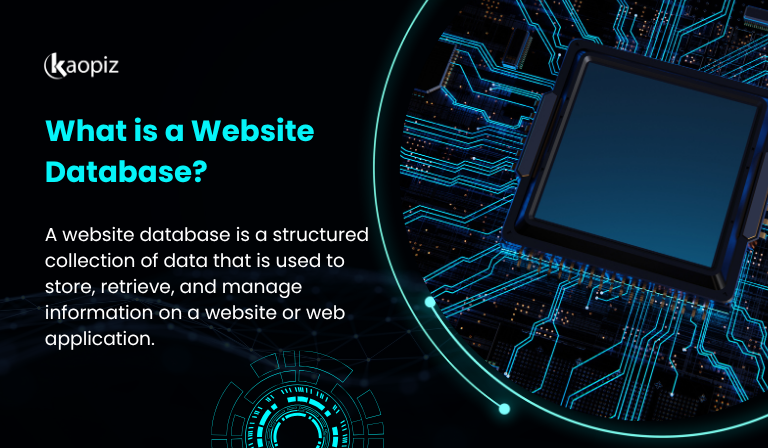
At the heart of every web database application, you’ll find a Database Management System (DBMS), which helps organize and manage the data. This system ensures that data can be easily added, updated, and accessed without compromising speed, security, or integrity.
Key Elements of a Website Database:
- Tables: Data is organized into tables (in relational databases), where each row represents a data entry, and each column represents a specific attribute of that data.
- Queries: A query is a request to retrieve, update, or delete data from the database. The database responds by returning the required information.
- Relationships: In relational databases, tables are often linked together using keys, establishing relationships between pieces of data (for example, linking user data to order data).
- Schemas: The schema defines the structure of the database, including tables, fields, and relationships.
In simple terms, database websites make it possible to run websites that require user interaction, dynamic content, and continuous updates, such as social media platforms, online stores, and blogs.
Which Websites Require a Website Database?
Dynamic websites are the ones that require a website database. Whether it’s an online store, a blog with user comments, or an application requiring user authentication, these websites depend on databases to manage their dynamic nature and provide personalized content to their users.
To understand which websites need a database, it’s helpful to distinguish between static and dynamic websites.
Static Websites
Static websites deliver the same content to every visitor. They are typically simple sites like company portfolios, landing pages, or documentation sites. These websites don’t require a database since the content doesn’t change unless manually updated by the developer.
Dynamic Websites
Dynamic websites interact with users and change content in real-time, which requires a website database. These sites include:

- E-Commerce websites (e.g., Amazon, Shopify) for managing products, orders, and customer data.
- Content Management Systems (CMS) (e.g., WordPress, Drupal) for storing articles and user-generated content.
- Social media platforms (e.g., Facebook, Instagram) for storing profiles, posts, and interactions.
- Web applications (e.g., Trello, Slack) for real-time data and user collaboration.
- Online learning platforms (e.g., Udemy, Coursera) to track course progress and user data.
These websites require a database to store and update data dynamically, offering personalized and interactive user experiences.
Key takeaways:
- Static websites: Deliver fixed content (e.g., company portfolios, brochures) and generally do not need a website database.
- Dynamic websites: Offer personalized experiences and real-time updates, requiring a database to store and manage content and user data.
How Does a Website Database Work?
A website database stores and manages the data required for dynamic websites. Here’s how it works:
- User Request: When a user interacts with a website (e.g., clicking a button or submitting a form), the request is sent from their device to the application layer (backend).
- Processing: The backend processes the request using business logic, then formulates a query to retrieve data from the database.
- Data Retrieval: The database fetches the requested data and sends it back to the backend, which then displays it on the user’s device.
For faster performance, frequently requested data may be cached to avoid repeated database queries.
Types of Website Databases
When selecting a database for your web application, it’s helpful to look at types of website databases and their web application database examples that align with your business needs. Here’s an overview of the main types:
Relational Databases
Relational databases store data in structured tables with rows and columns. They use SQL (Structured Query Language) to query and manipulate data. These databases are ideal for applications that require strong data integrity and relationships between data, such as e-commerce websites, CMS, and financial systems.
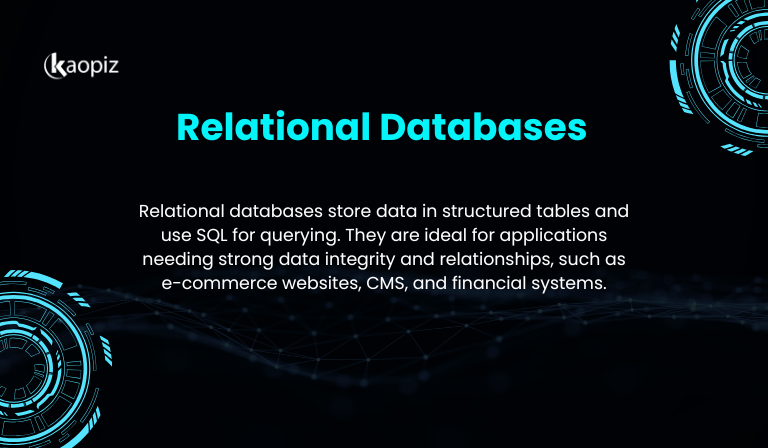
- Database website examples: MySQL, PostgreSQL, Microsoft SQL Server, Oracle Database, SQLite
- Best for: Structured data with complex relationships, such as product inventories, user accounts, and transactions.
NoSQL Databases
NoSQL databases are designed to handle unstructured or semi-structured data. They do not follow the traditional relational model and offer greater flexibility in how data is stored and queried. These databases are highly scalable and suitable for applications that require handling large volumes of data, like real-time applications or social media platforms.
- Database website examples: MongoDB, Cassandra, CouchDB, Firebase Realtime Database, Redis
- Best for: Big data, real-time applications, social media platforms, and websites with high volumes of user-generated content.
Cloud-Hosted Databases
Cloud-hosted databases are managed databases offered by cloud service providers. These databases are hosted in the cloud, ensuring high availability, automatic scaling, and reduced infrastructure management. Cloud-hosted databases are ideal for businesses looking to reduce overhead and scale their operations quickly and efficiently.
- Database website examples: Amazon Aurora, Google Cloud SQL, Azure SQL Database
- Best for: Startups and enterprises needing a reliable, scalable solution with minimal maintenance.
Hybrid and Graph Databases
Hybrid databases combine features of both relational and NoSQL databases, allowing them to handle both structured and unstructured data. Graph databases, a specific type of hybrid database, are optimized for managing complex relationships between data points, making them ideal for use cases like social networks and recommendation systems.
- Database website examples: Neo4j (Graph Database), ArangoDB (Multi-model Hybrid Database), Couchbase (Hybrid NoSQL Database)
- Best for: Applications involving complex relationships, such as social networks, fraud detection, and recommendation engines.
How Database Management Systems Help Run Business Operations
A DBMS plays a crucial role in helping businesses manage, store, and retrieve data efficiently.
Here’s how DBMS contribute to smoother business operations:
- Centralized Data Management: DBMS stores all data in one place, making it easier to access and manage across departments.
- Improved Decision-Making: It provides real-time, accurate data for informed decision-making.
- Streamlined Processes: Automates tasks like inventory tracking, order processing, and customer management to reduce manual work.
- Data Security and Compliance: Offers security features like encryption and access control, ensuring data protection and regulatory compliance.
- Scalability and Flexibility: Easily scales to accommodate growing data needs without compromising performance.
- Data Integrity: Enforces rules to maintain consistent and accurate data, reducing errors.
- Enhanced Collaboration: Facilitates real-time data sharing across departments, improving teamwork and alignment.
Key Features of an Ideal Website Database for Singapore SMEs
When choosing a database for websites, Singapore SMEs must evaluate key features that meet their business needs and comply with regulatory standards. Consider the following factors when making your decision:
- Scalability: The database should handle increasing amounts of data as your business grows, ensuring smooth performance even during traffic spikes.
- Security: With data protection laws like PDPA in Singapore, an ideal database must offer robust encryption, access controls, and secure data storage.
- Performance: Fast data retrieval and efficient queries are essential to ensure a seamless user experience, especially during peak traffic.
- Cost-Effectiveness: For SMEs, the database should provide a balance of features and affordability, often with cloud-hosted or managed service options to reduce overhead.
- Flexibility: The ability to handle both structured and unstructured data, allowing you to store customer information, transaction records, and media content.
- Data Backup and Recovery: Automatic backups and disaster recovery capabilities are essential for minimizing data loss and ensuring business continuity.
- Ease of Integration: The database should integrate easily with other software, such as CRM systems or payment gateways, to streamline business processes.
- Compliance with Local Regulations: It should support Singapore’s PDPA and other local compliance requirements to protect sensitive customer information.
Top 10 Databases for Web Applications to Consider in 2025
Choosing the right database is essential for ensuring the performance, scalability, and security of your web applications. Here is the list of website databases to consider for your web projects in 2025:
| Database | Type | Key Features | Best For |
|---|---|---|---|
| PostgreSQL | Relational (SQL) | ACID compliance, full SQL support, scalability, and advanced data types | Complex applications, data analytics, and geospatial data |
| MySQL | Relational (SQL) | High performance, reliability, easy to use, and widespread community support | Websites, e-commerce platforms, and CMSs |
| Microsoft SQL Server | Relational (SQL) | Advanced security, integration with Microsoft tools, and robust querying | Enterprise applications, business intelligence, and data warehousing |
| Oracle Database | Relational (SQL) | Highly reliable, secure, and scalable with robust data management | Large enterprises and mission-critical applications |
| SQLite | Relational (SQL) | Lightweight, self-contained, serverless, and low maintenance | Mobile apps, small websites, and embedded systems |
| MongoDB | NoSQL | Flexible schema, scalability, high performance with large datasets | High-volume, unstructured data, and real-time applications |
| Firebase Realtime Database | NoSQL (Real-Time) | Real-time data sync, automatic scaling, easy integration with Google services | Mobile and web apps requiring real-time syncing |
| Redis | NoSQL (In-memory) | Ultra-fast data processing, in-memory storage, and support for complex data types | Caching, real-time applications, and session management |
| Amazon Aurora | Cloud-hosted (SQL) | Fully managed, high availability, compatible with MySQL and PostgreSQL | Cloud-native applications, high availability systems |
| Neo4j | Hybrid/Graph Database | Efficient graph traversal, flexible schema, and optimized for complex queries | Applications involving complex relationships, social networks, and fraud detection |
PostgreSQL
PostgreSQL is a powerful, open-source relational database known for its robustness, scalability, and ability to handle complex queries. It’s widely used for managing structured data and performing analytics, while maintaining high performance and data integrity.
Examples: E-commerce websites, data analytics platforms, geospatial applications
Key Features:
- ACID Compliant for data integrity
- Extensible with custom data types and functions
- SQL & NoSQL support (JSON storage)
- Advanced querying with support for joins and full-text search
- High availability with replication and failover capabilities
Best For: Complex data relationships, e-commerce, financial systems, and data analytics.
MySQL
MySQL is one of the most popular open-source relational databases, known for its speed, reliability, and ease of use. This database of websites is widely used in web applications, from small websites to large-scale enterprise systems. MySQL is a well-established choice for handling structured data and is optimized for fast read/write operations.
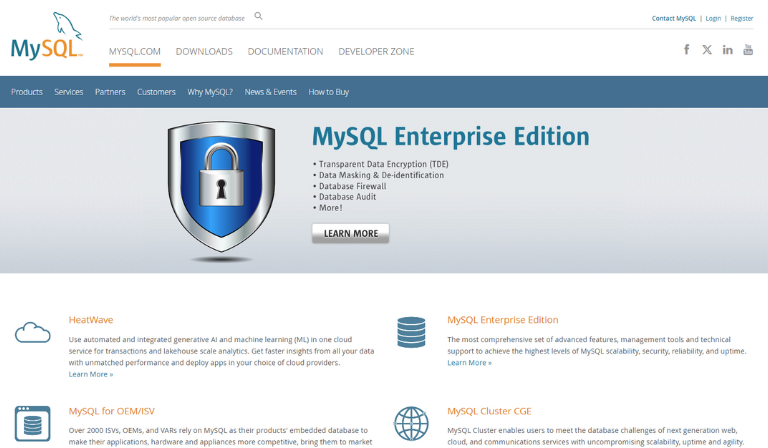
Examples: CMS, e-commerce platforms, web-based applications
Key Features:
- ACID Compliant for data integrity
- High performance for fast queries and data retrieval
- Scalable to handle large databases and high traffic
- Replication for high availability and redundancy
- Cross-platform support (Linux, Windows, macOS)
Best For: Web applications, e-commerce sites, and content management systems require a reliable, fast, and scalable database.
Microsoft SQL Server
Microsoft SQL Server is a robust, enterprise-grade relational database management system (RDBMS) developed by Microsoft. Known for its high availability, security, and deep integration with other Microsoft products, SQL Server is ideal for large-scale applications that require strong data integrity and complex querying capabilities.
Examples: ERP systems, financial and business intelligence applications, data warehousing, and analytics platforms
Key Features:
- ACID Compliant for ensuring reliable and consistent transactions
- Advanced security features, including encryption and data masking
- High availability with built-in features like Always On Availability Groups
- Data warehousing capabilities with strong support for large-scale data analysis
- Integration with Microsoft tools like Power BI, Azure, and Excel
Best For: Large enterprises and organizations with business intelligence, financial systems, and data warehousing needs that require secure, high-performance databases.
Oracle Database
Oracle Database is a highly reliable, scalable, and RDBMS used by enterprises worldwide. Known for its ability to handle large volumes of data and complex workloads, Oracle is widely used in mission-critical applications across industries such as finance, healthcare, and telecommunications.
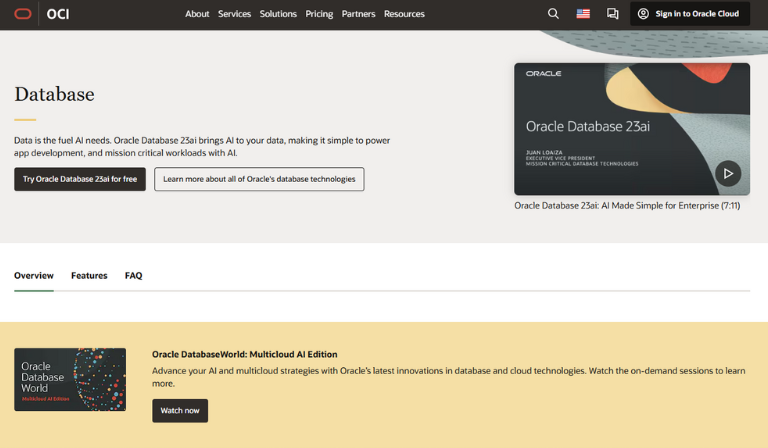
Examples: financial systems, ERP, CRM systems
Key Features:
- ACID Compliant for data consistency and integrity
- Advanced security features like encryption, auditing, and access controls
- High scalability with support for both vertical and horizontal scaling
- Data partitioning and clustering for high availability and load balancing
- Comprehensive support for large, complex databases and workloads
Best For: Large enterprises require a robust, scalable, and secure database for mission-critical applications, financial systems, and data warehousing.
SQLite
SQLite is a lightweight, serverless relational database engine that is widely used in mobile applications, embedded systems, and small-scale web applications. Unlike traditional relational databases, SQLite stores data in a single file on the disk, making it easy to deploy and use with minimal setup and overhead.
Examples: Mobile applications (iOS, Android), small websites and personal projects, embedded systems, and IoT devices
Key Features:
- Self-contained for easy deployment and minimal configuration
- Lightweight with low resource consumption, perfect for low-power devices
- Cross-platform support across various operating systems
- Zero configuration with no server setup required, reducing complexity
- ACID Compliant for reliable, transactional data storage
Best For: Mobile apps, small websites, and embedded systems require a simple, low-maintenance database solution.
MongoDB
MongoDB is a popular, open-source NoSQL database designed for handling large volumes of unstructured or semi-structured data. It uses a flexible document model (JSON-like format) to store data, making it highly scalable and ideal for modern web applications that require fast and flexible data handling.
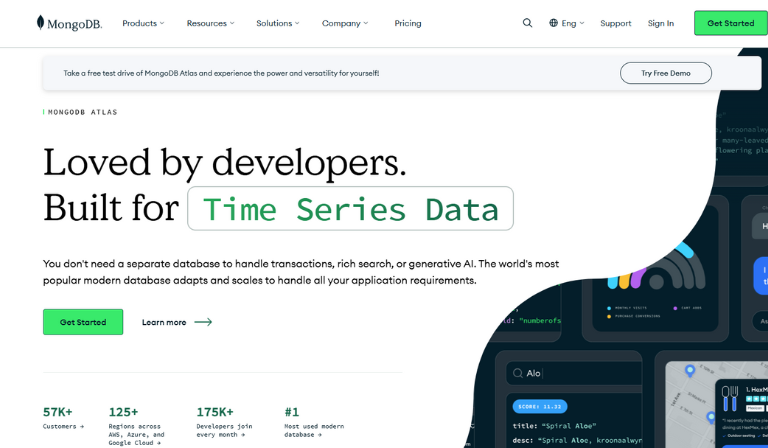
Examples: Real-time analytics platforms, social media networks, CMS
Key Features:
- Flexible schema for unstructured and semi-structured data
- Scalable with horizontal scaling and sharding for handling large datasets
- Document-oriented storage with support for JSON-like documents
- High performance for read and write-heavy operations
- Built-in replication and automatic failover for high availability
Best For: Real-time applications, big data solutions, social media platforms, and websites require flexibility and scalability for rapidly changing data.
Firebase Realtime Database
Firebase Realtime Database is a NoSQL database that allows for real-time data syncing across all clients. It is designed for building mobile and web applications where data needs to be updated and synchronized in real time, such as chat apps or live collaboration tools.
Examples: Messaging apps, collaborative platforms (e.g., Google Docs-style apps), real-time game leaderboards
Key Features:
- Real-time data synchronization across all connected devices
- Fully managed with no server-side setup or maintenance required
- Automatic scaling to handle growth in app traffic and data
- Offline support for mobile apps, allowing users to interact with data even when offline
- Easy integration with other Firebase services, such as authentication and hosting
Best For: Mobile apps, live data applications, and projects requiring instant data updates, collaboration, and offline capabilities.
Redis
Redis is an open-source, in-memory NoSQL database primarily used for caching, real-time data processing, and high-performance applications. Known for its ultra-fast data retrieval, Redis stores data in memory rather than on disk, making it ideal for use in cases that require low-latency access.

Examples: Session stores in web applications, real-time analytics platforms, message queues, and pub/sub systems
Key Features:
- In-memory storage for ultra-fast data retrieval and low latency
- Data structures like strings, lists, sets, hashes, and sorted sets for flexible data storage
- Persistence options to save data to disk for durability, while still operating primarily in memory
- Pub/Sub messaging for real-time notifications and event-driven architectures
- Replication and high availability with built-in failover capabilities
Best For: Caching, real-time applications, session management, and message brokering are where speed and low latency are critical.
Amazon Aurora
Amazon Aurora is a cloud-hosted relational database service from AWS that is compatible with MySQL and PostgreSQL. Aurora provides the reliability and performance of high-end commercial databases at a fraction of the cost. It’s designed to offer automatic scaling, high availability, and strong security features, making it ideal for cloud-based systems.
Examples: Enterprise applications, high-traffic websites, e-commerce platforms, SaaS applications
Key Features:
- Fully managed by AWS with automated backups, patching, and failover
- High availability with multi-availability zone replication and automatic failover
- Scalable up to 64TB of storage, with auto-scaling capabilities based on demand
- Performance up to 5 times faster than MySQL and twice as fast as PostgreSQL
- Security with automatic encryption, VPC isolation, and IAM integration
Best For: Cloud-native applications, high-performance databases, and enterprise applications require scalability, availability, and minimal management.
Neo4j
Neo4j is a leading graph database that is optimized for managing and querying complex relationships between data. Unlike traditional relational databases, Neo4j uses graph structures with nodes, edges, and properties to represent and store data.
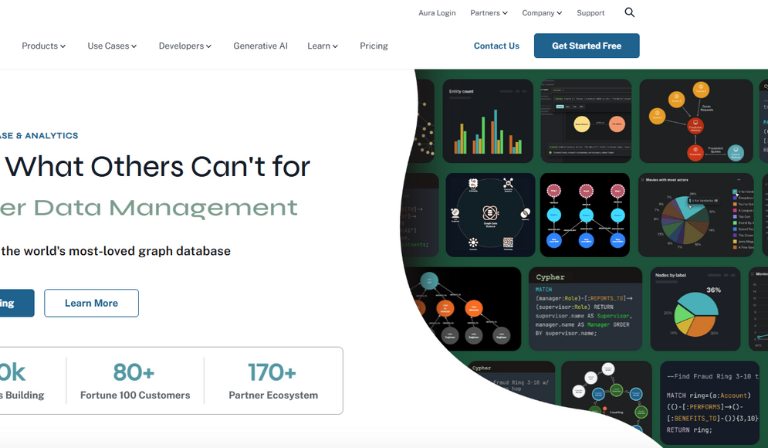
Examples: Social media networks, recommendation systems, fraud detection platforms, network analysis
Key Features:
- Graph-based data model for handling complex relationships between data points
- Scalable to handle large and interconnected datasets efficiently
- High performance for complex queries involving multiple relationships and large data sets
- Cypher Query Language for intuitive, efficient querying of graph data
- Real-time data processing for dynamic applications
Best For: Social networks, recommendation engines, fraud detection, and network analysis, where relationships between data are critical.
How to Choose the Right Database for Your Web Application (+ Singapore-Specific Tips)
Selecting the right database for your web application is crucial for performance, scalability, and long-term success. In this section, we will guide you on how to choose a website database and provide Singapore-specific tips to help you make the best decision.
Key Considerations When Selecting a Website Database
When selecting a database for your website, it’s important to consider several key factors to ensure it meets your specific needs:
- Data Structure: Determine if your data is structured, semi-structured, or unstructured. Relational databases are great for structured data, while NoSQL databases are ideal for unstructured or rapidly changing data.
- Scalability: Choose a database that can scale your business. Cloud-hosted databases like Amazon Aurora offer automatic scaling as your website traffic and data grow, while self-hosted databases may require manual scaling.
- Performance: Consider the speed and responsiveness needed for your application. For real-time data processing, consider in-memory databases like Redis or Firebase Realtime Database for fast, low-latency access.
- Security: Ensure the database offers strong security features, such as data encryption, access control, and compliance with local data protection regulations.
- Maintenance and Support: Managed cloud databases like Google Cloud SQL or AWS RDS to reduce the operational burden, offering automatic backups and updates. If you have the resources for manual management, self-hosted databases may provide more control.
- Cost: Balance your budget with the required features. Open-source relational databases like MySQL and PostgreSQL are cost-effective, while cloud databases offer flexible pay-as-you-go pricing but may incur higher costs at scale.
Tips for Singapore Businesses
Here are some tips specifically for businesses in Singapore:
- Leverage Cloud-Hosted Databases: Use Amazon Aurora or Google Cloud SQL for easy scaling, high availability, and automatic backups with minimal management.
- Ensure PDPA Compliance: Choose databases with built-in data encryption and access controls to comply with Singapore’s PDPA for handling personal data.
- Cost-Efficiency for SMEs: Take advantage of free-tier and pay-as-you-go models offered by cloud providers like Firebase and AWS RDS to keep costs manageable.
- Choose Databases with Local Support: Opt for services with strong local support, such as AWS, ensuring timely assistance and reliable service.
- Consider Multi-Region Deployment: For businesses with regional customers, use databases with multi-region replication to ensure high availability and fast response times.
Trends in Website Databases for 2025 and Beyond
As technology evolves, website databases are becoming increasingly sophisticated to meet the demands of modern web applications. Here are some key trends to watch for in 2025 and beyond:
- Cloud-Native Databases: Cloud databases like Amazon Aurora and Google Cloud SQL dominate due to their scalability, security, and cost-efficiency.
- Hybrid Databases: Hybrid databases that combine relational and NoSQL models, such as Couchbase, will grow in popularity for managing both structured and unstructured data.
- AI-Powered Databases: AI-driven databases will automate tasks like query optimization and provide real-time data insights, enhancing database efficiency.
- Edge Databases: Edge computing and edge databases will process data closer to the source for reduced latency, benefiting IoT and real-time applications.
- Serverless Databases: Serverless databases will automatically scale and allow businesses to pay only for resources used, reducing costs and management efforts.
- In-Memory Databases: In-memory databases like Redis will continue to rise due to their fast data retrieval for real-time analytics and personalization.
Why Choose Kaopiz for Website Database Development
At Kaopiz, we specialize in delivering customized website database solutions that are scalable, secure, and performance-driven.

Here’s why we are the ideal partner for your website database development needs:
- Expertise in Diverse Database Technologies: We have deep expertise in both relational and NoSQL databases, ensuring you get the right database solution tailored to your business needs.
- Scalable Solutions for Growing Businesses: Kaopiz provides scalable database solutions, ensuring your website can handle increased traffic and growing data needs without compromising performance.
- Data Security and Compliance: We prioritize data security and ensure compliance with local regulations, such as Singapore’s PDPA. From encryption to access control, we implement robust security features to protect sensitive business data.
- Proven Track Record: With 10+ years of experience and 500+ successful projects, we’ve helped businesses across various industries, including e-commerce, healthcare, finance, and more, build and manage their website databases effectively.
- End-to-End Development and Support: From the initial consultation and design phase to full implementation and ongoing maintenance, Kaopiz provides end-to-end database development services in Singapore and globally.
Choosing Kaopiz means partnering with a team that understands the complexities of website database development and delivers solutions tailored to your business. Whether you need web database services, a relational database, or a NoSQL solution, Kaopiz is here to ensure your website runs smoothly and scales with ease.
Conclusion
Choosing the right website databases is crucial to ensuring optimal performance, scalability, and security. Whether you need a relational database, a NoSQL solution, or a cloud-hosted service, it’s important to select one that aligns with your data structure, performance needs, and growth potential.
As trends evolve, technologies like cloud databases, real-time data syncing, and AI-powered solutions are shaping the future of database website development.
FAQs
- Which Database Is Best for Large-Scale Web Applications?
- For large-scale web applications, relational databases like PostgreSQL and MySQL are the best website databases for structured data and complex relationships. For applications with high scalability and flexibility, NoSQL databases like MongoDB or Cassandra are ideal. Additionally, cloud-hosted databases such as Amazon Aurora can offer scalability with minimal maintenance.
- Can I Use Multiple Databases in One Application?
- Yes, it’s possible and sometimes necessary to use multiple databases within a single application. This approach, known as polyglot persistence, allows you to leverage the strengths of different databases—for example, using a relational database for transactional data and a NoSQL database for real-time data or logs.
- What’s the Best Database for a Startup MVP in Singapore?
- For a startup MVP, cost-efficiency and speed of development are crucial. MySQL or PostgreSQL are excellent choices for relational data and are free to use. If your application requires real-time data and flexibility, Firebase Realtime Database or MongoDB could be great NoSQL options. Additionally, cloud databases like Google Firestore offer scalability without the overhead of managing infrastructure.
Trending Post
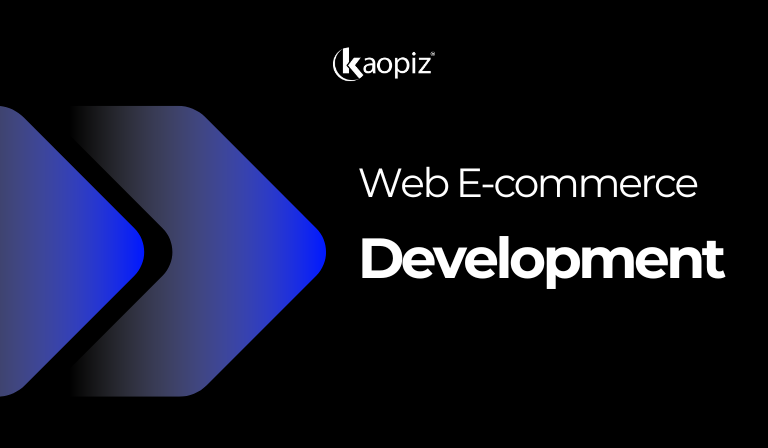


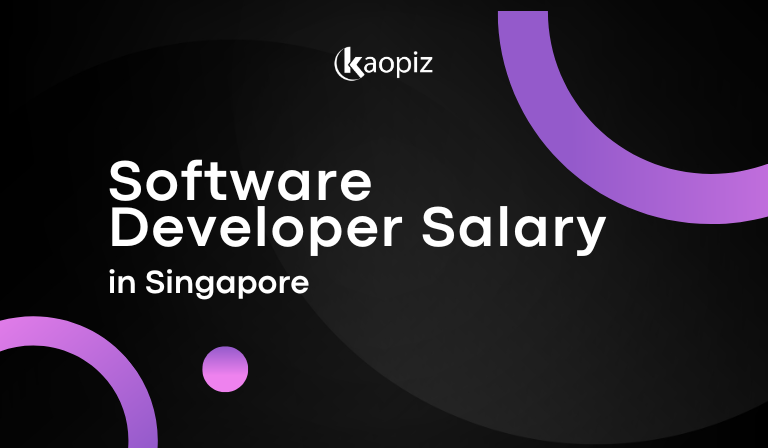

















No Comments yet!